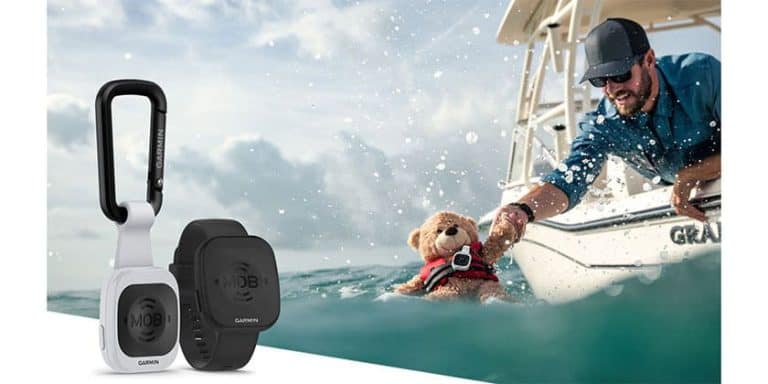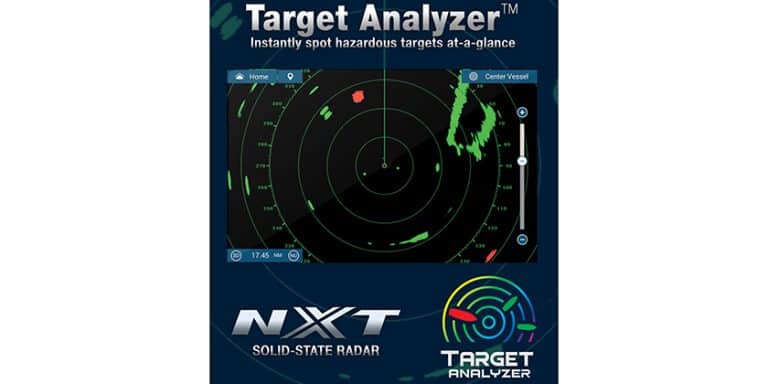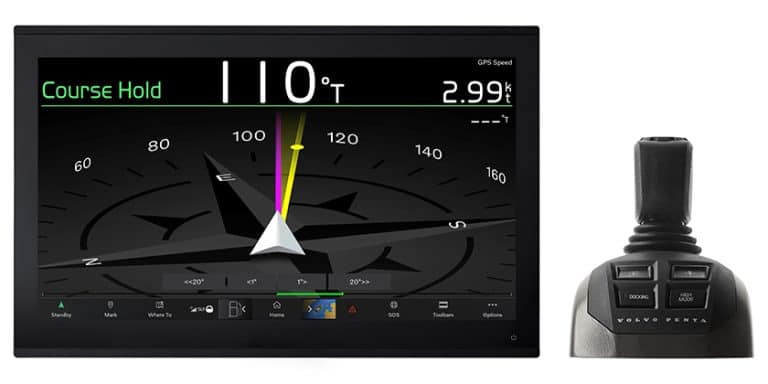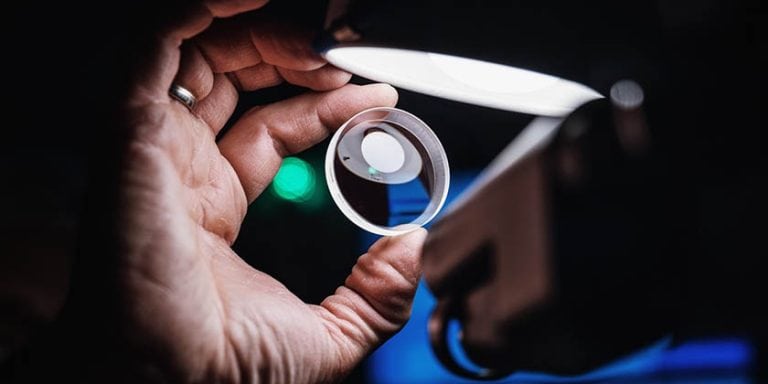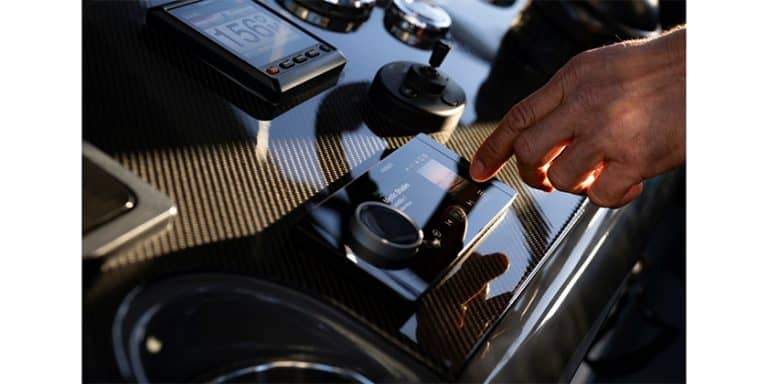VHF Radio
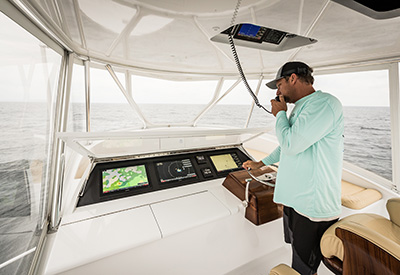
Photo Credit – Garmin
On board many pleasurecraft, only the compass is more neglected and taken for granted than the VHF radio. And that is understandable – wrong but understandable.
Most of us cruise in familiar waters, close to home and we are there to enjoy the good weather, not to fight a storm. So fortunately, we are almost never in an emergency situation and the VHF radio that was installed into the dashboard or bolted to the binnacle top when we bought the boat, is simply not used that much. And, it’s never upgraded as long as it keeps working.
That’s where we need to improve. The latest VHF radios have simply amazing and potentially life-saving capabilities, yet they are quite reasonably priced with even the high-end units costing under a grand and more basic sets just a few hundred.
The latest offerings from Garmin, Icom, Standard Horizon, Raymarine and others now include features like Automatic Identification Systems (AIS) designed to enhance convenience and safety, Digital Selective Calling (DSC), a global protocol that uses channel 70 to transmit and receive digital messages. VHF radios equipped with DSC can send and receive digital emergency messages, private calls and general calls and let you call attention to VHF calls by using stored Maritime Mobile Service Identity (MMSI) numbers. DSC significantly improves the chances of rapid rescue.
In this Canadian Yachting Marine Electronics special section, we will cover important points of VHF radio licensing, operator protocol and etiquette, as well as how to get the most value from your VHF.
We also have a separate section on AIS and more technical detail on the systems in the USA for readers who are coastal or Great Lakes cruisers and who are likely to get into American waters.
Read on and rediscover the huge value in your VHF radio!
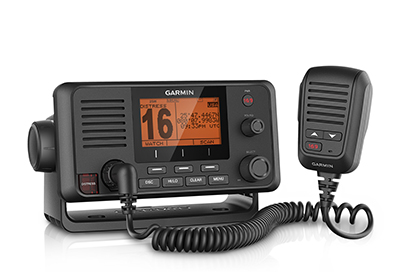
Credit: Garmin
Garmin VHF 210AIS
The Garmin VHF 210 AIS is a fixed mount radio that can display AIS information on your chart plotter to enhance communication, situational awareness and collision avoidance.
Communication and situational awareness are critical on the water, especially in reduced visibility or darkness. Garmin’s VHF 210 AIS was designed to complement their latest GPSMAP chart plotters and multifunction displays. It provides standard Class D digital selective calling [DSC] functionality with your user programmed Maritime Mobile Service Identity (MMSI) and it’s easy to install and use. It’s a plug-and-play unit running on the NMEA 2000 network to your compatible navigation suite. It’s preprogrammed with US, Canadian and international Marine channels. www.garmin.com
Maritime Mobile Service Identity (MMSI)
Industry Canada, as the radio licensing body in Canada, is responsible for the issuance and management of Maritime Mobile Service Identity (MMSI) numbers. To obtain an MMSI, applicants must contact their nearest Industry Canada office and provide the necessary vessel or coast station details. Vessel owners must also provide specific information regarding installed radio equipment and emergency contacts. If the vessel is not currently licensed and not exempt from licensing by the Radiocommunication Regulations – section 15.2, a radio licence will also be required. It should be noted that vessels not requiring a radio licencemay still be issued an MMSI.
In order to obtain an MMSI, Industry Canada requires that the applicant supply specific information depending on the kind of MMSI requested. There are three kinds of Maritime Mobile Service Identities:
• ship station MMSIs;
• coast station MMSIs.
• ship station group MMSIs; and
Application forms for each kind of MMSI are available from Industry Canada district offices and from Industry Canada’s Spectrum Direct website at: http://sd.ic.gc.ca.
A Guide to Maritime VHF Radio for Pleasure Craft
By Ken Goodings
Practical User Tips and Broadcast Etiquette
Marine VHF Radio is a shared resource, so it’s important to be community-minded when using your radio. It’s not a private telephone;so anyonewith a maritime radio in a nearby vessel can hear every word you say!
Here are a few tips formore efficient VHF operation so that you won’t trigger groans from your boating neighbours, or garner the reputation of being, “That Boat.”
– VHF CH-16. It’s the calling Channel-
It’s worldwidemaritime practice to listen to VHF Ch-16 while vessels are under way. However, some boaters like to monitor a “Buddy Channel” when cruising or anchoring with friends. Please remember that if you’re not listening, or at least scanning Ch-16, you will miss important Coast Guard Radio weather announcements, distress calls from other vessels near you, or perhaps another boat trying to warn you about a navigation hazard. Scanning both Ch-16 and several other channels of interestduring the daytime is a great idea if you don’t want to miss anything. Then you’ll hear all of the commercial traffic on 16 and other recreational vessels calling one another as well. Always listen to Ch-16 when your boat is moving. It’s the responsible thing to do.
Remember, too, that Ch-16 is the universal worldwideVHF channel for emergency and calling. After making an initial contact with another boat on 16, please switch your radio to another simplex (Ship to Ship) channel. Whenever you happen to hear a boater unwittingly chatting away on 16, please try to be considerate. Keying or whistling over someone with your microphone won’t solve anything, and this kind of passive-aggressive behaviour is considered to be low class, and actually illegal. Politely advising them that there may be a hundred or more vesselsoverhearing their conversation on 16 is probably sufficient. Mariners often forget to switch to a working channel. At the end of their conversation, it’s quite amusing to hear them say on 16, “This is Soggy Bottom going back to 16…Oops!!!”
It’s worth clarifying the Channel 16/9 buttonthat’s found on all marine VHF transceivers manufactured for the Canadian and United States pleasurecraft market. In Canada and elsewhere in the world, the official calling channel for every class of vessel is always Ch-16; never Ch-9 in any situation. In the USA, due to their larger pleasurecraft population, recreational boaters are encouraged to monitor and use Ch-9 as a hailing channel to reduce traffic on Ch-16. That’s why you’ll find a 16/9 button on the radio. However, while cruising in Canada, we’re all waiting for your call on Ch-16!
There’s a secondimportant difference between operating your VHF radio in Canadian, in American, or in International waters. We’ll get to that in a short while.
-Buddy Channels-
Groups of boats who are constantly calling back and forth all day might consider scanning another “Buddy” calling channel of their own. This will help to reduce the number of calls on 16, especially in the early morning or evening.All VHF radios and handy-talkies can be easily set to scan two or more channels, e.g. 16 and 68. We know from experience that frequent buddy boat calls on 16 will often cause many people to simply switch off their radios. Boaters who completely turn off their VHF for any reason diminishes the potentially lifesaving on-the-water security network forus all. It’s polite practicethat if you should need to call and wake up your friend’s boat to set out for that special fishing spot at “oh-dark-thirty”, you might consider using a pre-arranged channel other than 16. This will avoid unnecessarily awakening the multitude of sleepy cruisers who are monitoring that16 calling channel as a security precaution while anchored in a quiet bay overnight.
-Voice Procedure-
Short-range Maritime VHF radio voice procedures can be very different from methods used forso-called “Weak Signal” long-range High-Frequency SSB radio. After activating the push-to-talk button on your VHF, pause for a half second, then speak clearly and slowly, especially when giving telephone numbers or your boat name. Familiarity and use of the International Phonetic Alphabet to spell out difficult words or phrases can beof great benefit to those listeners for whom French or English is not a first language. Remember that when using a VHF cockpit microphone or portable hand held radio, the ambient engine or wind noise on your boat has a debilitating effect on the clarity of your voice.It’s a good reason to speak just a little over normal conversational tone when transmitting from the cockpit radio. If you speak across the microphone instead of straight into it, your voice will sound more natural and may be better understood. Don’t forget to release the microphone button to listen for a response.
Once you have made your first daily contacts with nearby friends on VHF,it isn’t really necessary to use frequent reiterations of the traditional three-by-three call; “Leaky Tub, Leaky Tub, Leaky Tub, this is yacht Soggy Bottom, yacht Soggy Bottom, yacht Soggy Bottom, how do you read me?”Keep your local VHF radio calls shorter, perhaps using only a two-by-one. Either your friend’s crew is paying attention after hearing their own boat’s name twice, or they’re busy or ashore. Please wait at least five minutes before calling them again. I don’t know of any boaters with a VHF radio mounted in their boat’s head compartment for those early morning calls.Relax, give them a few moments, and then call them again. Similarly, after an unsuccessful attempt to contact another boat, we might hear the phrase, “Nothing heard, this is Soggy Bottom monitoring channel 16.” These procedures are common practice on long distance, SSB-HF frequencies, but arequite redundant on short range, full-quieting,FM-modulated VHF radio.
Better yet, instead of calling on 16, why not privately page your friend’s boat using the capabilities of your boat’s VHF-DSC radio. We’ll discussthis cool new technique in a future article, “Marine VHF and DSC – Don’t Leave Port Without It!”
Should you ever overhear someonenear your own boat being called unsuccessfully on Ch-16, going on the air to point out that the crew has left the boat to go shopping or take a land tour is a great disservice. You’ve now advertised the name of this vacant boat to everyone within 20 miles with a maritime VHF radio. Similarly, making dinner plans with friends on the VHF could very well put your vacant boat at risk. We’ve overheard boaters making marina dock reservations over the radio, complete withcredit card numbers. Radio is just one big party-line. Your conversation is definitely not private.Not everyone on VHF has honourable intentions.
– Radio Check –
After failing to contact their party on VHF,we often hear a station calling for a “Radio Check.” They’ve automatically assumed that their radio or antenna is now defective since they last used it. You’ll probably agree that the chance of a complete radio system failure within half a day’s time isprobably very low. Checking the operation of your radio anonymously by blowing into the mike while tuned to a calling channel is inconsiderate and also illegal. Please respect your neighbours and test your radio on another vacant working channel. If you do hear “Radio Check,”take them to a vacant working simplex channel, then give them your location and an honest opinion of their signal quality. This is much more helpfulthan automatically responding to every “Radio Check” with “Loud and clear,” especially if they’re a bit weak or scratchy.
We’ve all heard the entertaining result of a boat’s microphone accidently jammed under a cushion; all the while transmitting a complete and embarrassing play-by-play of cockpit chatter on a calling channel. Again, clicking your mike or calling out, “Check your microphone!” will only add to the general entertainment. That boat can’t hear anything on the radio, they’re transmitting!
– Break Break! –
Whenever you feel the need to interrupt an ongoing VHF conversation or want to be heard on a VHF radio, simplyshouting “Break” isn’t good radio etiquette. It’s an artifact from the old General Radio Service (CB) days. Saying“Break” on the radio correctlyindicates a separation between portions of your long message.Never use the term “Break” two or three times in succession unless there is an immediate threat to life or property. It’s much better to wait for a pause between transmissions and throw in your boat name. Incidentally, when you’ve finished your conversation with someone on the radio, it’s recommended that you wait a second or two before switching back to the calling channel. It’s not uncommon that someone else mayhave been waiting patiently to speak with you. There’s no rush after all, is there? After all, boating is supposed to be relaxing.
-Conservation of Power and Spectrum – Use Low Power –
Switch your VHF radio from HIGH power(25 watts) to LOW power (1 watt) when anchored, in a marina or in any port. It’s an unfortunate idiosyncrasy of the receiving circuitry of most VHF radios that you will hear the voice of a neighbouring boat’s 25 watt signal on many other channels at once. There’s nothing wrong with anyone’s radio. This overloading just happens.The use of low powerfor local conversations willhelp prevent you from being heard by distant vessels in other boating areas, which is a good thing,since you’re only talking to a vessel nearby. Imagine the turmoil caused, if many boats, all quite distant from one another, all try to simultaneously use the same channel on high power. Switching to low power eliminates this unintentional interaction and can make that channel availableby other boats.Try to remember to use HIGH transmit power only when at sea, and LOW power when in port. It’s a one-buttoncourtesy, and it’s also the law. Of course, if you need to contact someone farther away, by all means use high power, but LOW power should be your VHF radio’s default setting when docked or at anchor.
– Maritime VHF Band Plans – United States, Internationaland Canadian(U,I,C) –
Many boaters don’t really understand the differences between the threedistinctive Marine VHF channel sets or band plans. One might reasonably suppose that if you’re operating an Americanor Canadian registered boat, then you should stick with the US or Canadian channels, regardless of where you’re sailing. This is not so. In Canadian waters, use the Canadian setting “C.” In the USA, switch the radio to “U.” When cruising internationally, away from Canada and USA, it’s not the best idea to use the US or Canadian VHF band plan. Most vessels from other countries may not be able to reach you reliably on channels other than Ch-16 and 68.Use the International “I” setting on your VHF radio. Check with the local VHF radio band plan convention whenever you sail to a new country so that your radio is on the same page as everyone else around you.You might have to find this band plan switching procedure in your VHF operator’s manual. Depending on your brand of radio, it might not be very obvious.
– Maritime Radio Operating Certificate – Your personal radio operator’s permit –
First of all, in Canada, although a pleasure craft is not required by law to have a maritime VHF radio, these modern transceivers are now so inexpensive and reliable, it’s a great safety feature on any boat.Radio transmitting equipment in Canada must be certified under the applicable Canadian Radio Standard Specifications for use in Canada. In Canada, look for a label with an “IC Type Approval Number” label on the radio. This number is not the same as the FCC number which is required in USA.
For Canadian pleasure craft operators to legally use Maritime Radio in Canada, anoperator’s certificate of proficiency (ROC-M) is required by law. This plastic card is valid for your lifetime and is issued exclusively to individual Canadian pleasure craft operators by Canadian Power and Sail Squadrons (CPS-ECP).Every member of your crew needs to have their own ROC-M card. When they study the CPS-ECP material to receive it, they’ll also become well-trained radio operators. Why not get your whole crew to sign up for a CPS-ECP radio class nextfall or winter, have some fun together, and have everyone on your boatbecome certified in Maritime Radio? Marine Radio and other pleasure boating classes areregularly held by the local CPS-ECP squadron in locationsconvenient to your home or workplace. Here’s where to find the CPS-ECP Marine Radio class nearest you.
http://www.boatingcourses.ca/course-descriptions/maritime-radio-0
http://www.ecpquebec.ca/fr/node/41
– Cruising away from Canada? Your boat may need a radio licence too-
Although it’s not required for Canadian pleasure craft in Canada, should you and your pleasure craft ever cruise to the United States, or even further away to foreign countries, legal radio requirements change. In addition to the mandatory ROC-M operating certificate for each radio operator on your boat, there’s a second legal requirement to obtain and carry your vessel’s own Maritime Mobile Radio Station licence. This is a paper certificate which permits you to use marine radio equipment when sailing outside Canadian waters, and it includes your official maritime radio callsign. Industry Canada can issue your vessel’s marine radio station licence whichmust be renewed on-line annually. Here are links for further information.
https://www.tc.gc.ca/eng/marinesafety/oep-navigation-radiocomms-faqs-1489.htm
https://www.tc.gc.ca/fra/securitemaritime/epe-navigation-radiocomms-faqs-1489.htm
Do you find all of this a bit confusing? Well it certainly can be. However, if you attend the CPS-ECP radio classes to receive your personal lifetime ROC-M, you’ll be well on your way to becoming an expert marine radio operator and be very well-suited to help other boaters better understand what’s going on with their own boat’s VHF radio. Spread the word. Marine VHF radio on Canadian pleasure craft is a powerful life saving device, and its fun to use too!

